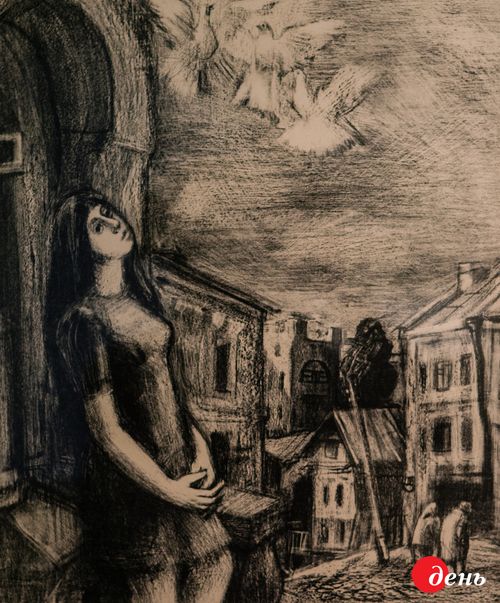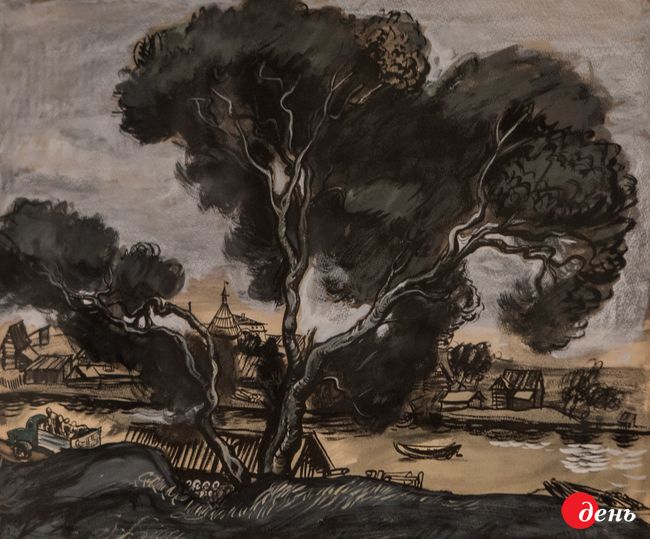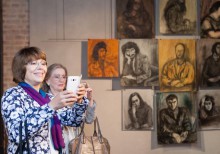“To work, to travel, to live, and to work again” is the motto of a Kyiv lady artist who lives in the US now. Anel Tolkachova is very diverse – she travels to many countries and experiments with techniques. But the exhibit that opened recently in Kyiv’s Art 14 gallery displays the works created in the 1960s-1970s. Exposition authors focused on the works that convey the atmosphere of the milieu of nonconformist artists in the mid-to-late 20th century.
Anel Tolkachova herself comes from the family of artists. Her father Zynovii Tolkachov was a well-known Ukrainian graphic artist, and her brother Illia also became a noted painter. The artist grew up in a motley artistic milieu and tried herself out in various fields – graphics, painting, illustration, and stage design.
“This exhibit was conceived some time ago,” says Kateryna Borysenko, founder of the Art 14 gallery. “I’ve known about Anel Tolkachova for a long time. She visited our gallery and showed her current works – they totally differ from what we show. There are still many 1960s-1970s works left in her Kyiv studio. When exhibit curator Hlib Vysheslavskyi and I saw them, we understood that they needed to be shown. For when an artist leaves, he or she is often forgotten. And these works are sort of time documents. I think they are quite worth being known.”

The hub of the exposition is a gallery of the portraits of artists. Most of the portraits were painted in Senezha, a country retreat near Moscow, where artists from all of the Soviet Union used to gather. “When we were mounting this exhibit, there were a few basic points based on one idea – Tolkachova expresses her time very well with the style, manner, and themes. The best illustration of this is her portraits of artists,” says Hlib Vysheslavskyi, exhibit curator, art critic, and artist. “These portraits are very psychological. Their heroes, Anel’s acquaintances, seem to go on speaking to her. She paints the inner world, not the appearance. She perceives an individual expressively, it is a live dialog. And the spectator is here like a third person who suddenly finds themselves in the room and seems to be eavesdropping on the conversation. For this reason, I even feel a bit embarrassed to look at these portraits.”
The second reference point of the exhibit is lithographs that depict, among other things, the live of artists at that time. You can see a master who draws from life in the studio and plein-air artists. The third cluster of works is landscapes drawn with charcoal, crayons, and in other techniques. “Tolkachova vested a landscape with her own features, the features of her soul. It was uncommon at the time. Most of the official artists drew not the condition of their soul but what was required ideologically – cheerfulness, merrymaking, ‘friendship of peoples,’ etc. But here we see the landscape as a condition of the soul. The artist paints nature during a rainfall and bad weather, she shows sadness and confusion,” Vysheslavskyi comments.

Anel Tolkachova belonged to the circle of progressive artists in the 1970s, who were not outright dissidents, but they were creating a “different,” non-ideological art. “These artists formed a certain small community,” Vysheslavskyi says. “What united them was love for art, the knowledge of its history and traditions. This created a micro-milieu to which it was an honor to belong, for these artists were really engaged in artistic work, not in propaganda. Their works were full of heart, the sense of life, and reflections on the world.”
Today, according to Kateryna Borysenko, Tolkachova’s works look more grotesque and resemble in a way illustrations to fairytales. The mood of the exhibited drawings is different. Besides, they reflect a much quieter rhythm of life than today. In front of these works, you want to keep silent and even to walk more slowly in order not to ruin the reproduced atmosphere of the time.” the Art 14 founder adds. “One of the pictures shows a couple that sits on the balcony and enjoys life – quietly, without any pomp. You can see that these people feel good. Anel seems to be showing a simple everyday life, but all this is very poetic.”
Anel Tolkachova’s exhibit will remain open at the Art 14 gallery until October 22.







